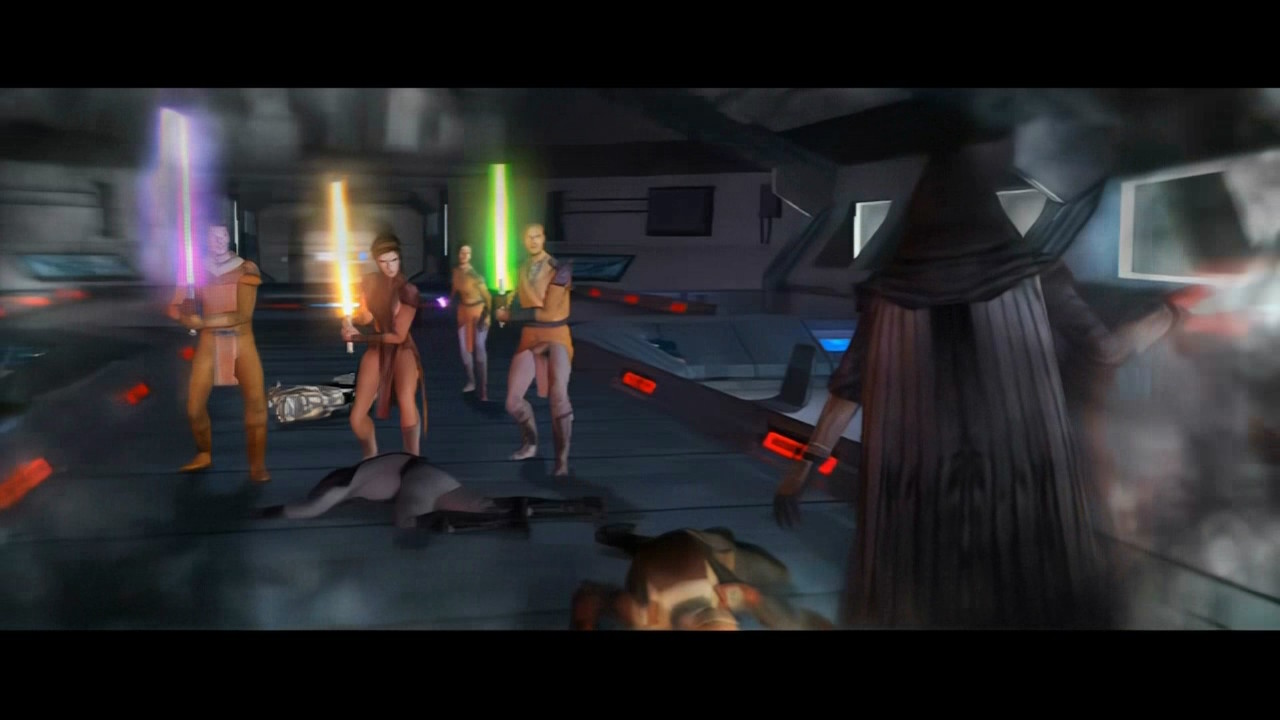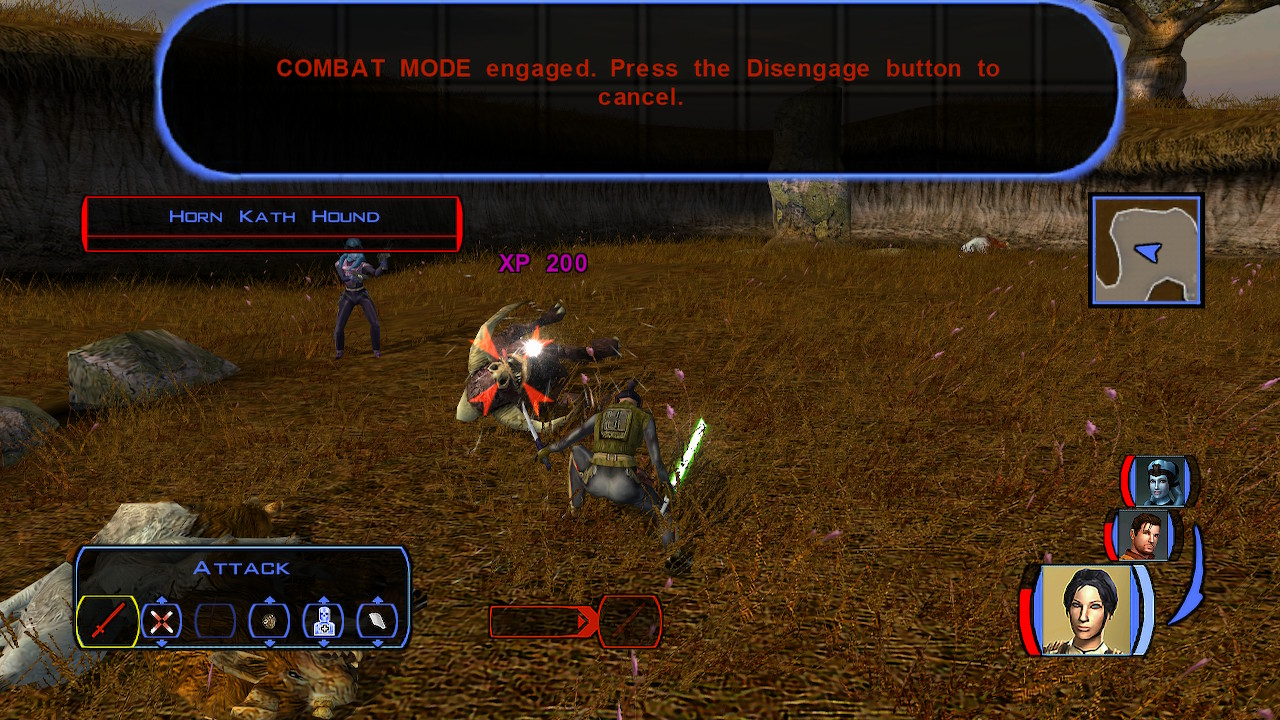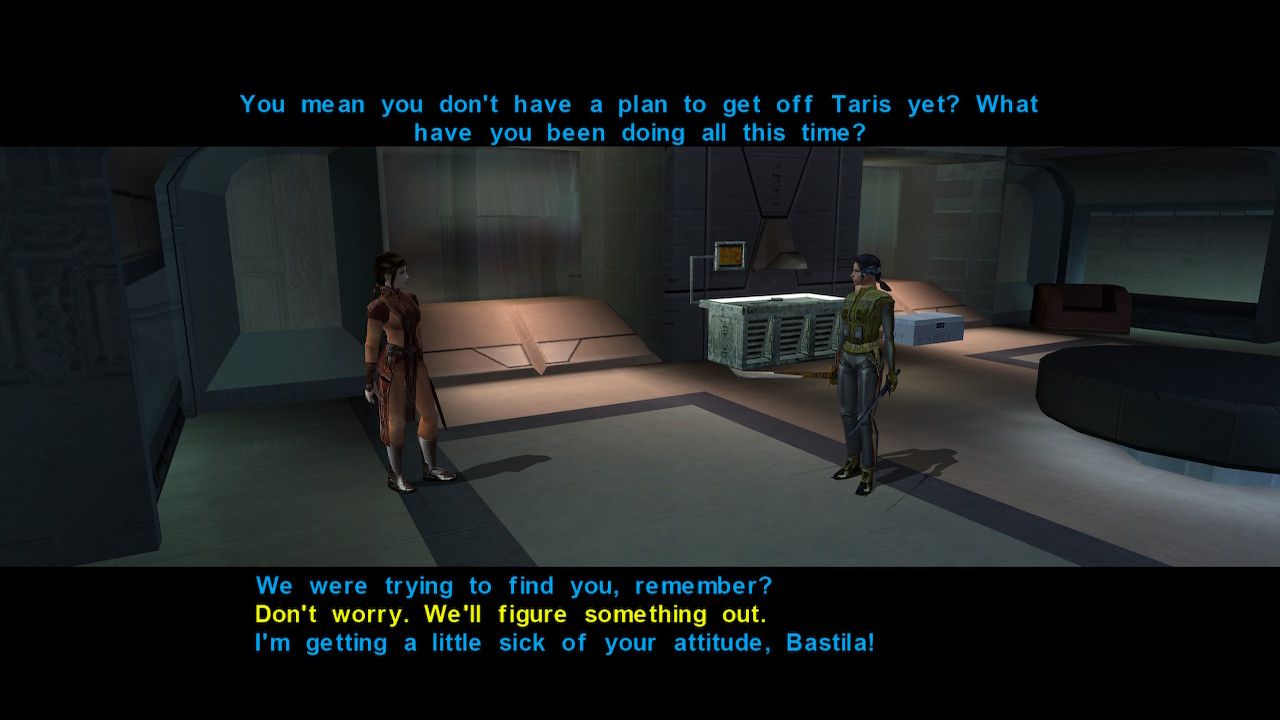Star Wars: Knights of the Old Republic initially released in 2003. Now, almost twenty years later, the classic sci-fi RPG has made its way to the Nintendo Switch. Is the Force still strong with this port, or has that sensitivity vanished with the passage of time? Let me preface this review by saying that this is the first time I’ve ever played Knights of the Old Republic. I’m not blinded by fond nostalgia when I state that I’m pleasantly surprised with just how well Aspyr’s port of the game holds up amongst the Switch’s current RPG lineup, though not without some caveats.
Years have passed since the dramatic and explosive aftermath of the war with the Mandalorians, and it seems as if the Republic (the current long established governmental force of a galaxy far, far away) might be on its last legs. Vaunted Jedi heroes Revan and Malak mysteriously turned to the Dark Side and have led a seemingly inexhaustible force of Sith against their former allies. All hope seems lost until a group of Jedi Knights are able to secure a victory against Darth Revan, though the repercussions of that battle are felt far and wide as Malak takes total control of the Sith. Players take on the role of a Republic soldier during an intense firefight that soon finds you crash landing on the planet of Taris and searching for the Jedi Bastila. Soon you’re caught up in a worlds-spanning battle between the Dark and Light Sides of the Force that could very well shape the fate of the entire galaxy.
Knights of the Old Republic is a Star Wars story at its very heart with all the aesthetic trappings of the franchise. Those who don’t at least have a modicum of love for the series would probably do best to look elsewhere for their RPG experience, though fans will certainly find enjoyment in getting their Jedi training on. The game captures the feel of the films beautifully in its planetary vistas, thrilling space battles, and hectic lightsaber duels. The music is grand in scope and brings to mind the soundtracks of the various Star Wars films wonderfully. If anything, I’d say that certain world-building elements that the films may not often have time to explore are fleshed out far more in Knights of the Old Republic, such as how humans interact with the other alien species. I’ve more than just a passing fondness for Star Wars in general, and I think Knights of the Old Republic might be one of my favorite stories set in this universe. I honestly regret that it took me so long to actually play the game!

Star Wars: Knights of the Old Republic is an earlier BioWare title, and gameplay elements now associated with the developer appear here, albeit in often simpler forms. At the start of the game, a basic character creator allows you to customize your player character. You’re given the option to choose between a male or female character, different job classes, and appearances, too. As an added touch, your choices do get mentioned from time to time throughout the game. You’ve free reign to give your character “voice” during story scenes and interactions, portraying them as helpful or as combative as you’d like. At certain points during the game, the decisions you make could have long-lasting repercussions for a specific character or a world you’re visiting. Perhaps the biggest example of this is your initial visit to the Wookie home-world. Certain story decisions also net you Light Side or Dark Side points which impacts how characters perceive you, not wholly unfamiliar to those who played Mass Effect and dealt with its Paragon and Renegade options. It is crucial to note that acquiring points for either side of the Force also helps player characters acquire differing Force Powers. Due to the way the story is presented and my familiarity with later BioWare titles, I was easily able to slip into the game’s presentation.
Given that this is a Star Wars title, combat is something that can’t be avoided. You’ll battle various hordes of Sith, enemy droids, and hostile alien creatures. The battle system basics are easy enough to pick up, though the numerical stats that go into it are somewhat confusing. You can choose to equip your party with melee weapons or blasters, and yes, Jedi party members can even equip the fabled lightsabers of their order! You’ll start default attacking once a target has been identified and battle initiates. A simple menu opens up with combat skills and abilities or items that can be selected. You’ll pick which action you’d like to perform next from that menu. You can also pause the game to go into the item menu at anytime if you need a stim to enhance your stats, for instance.
I found I much preferred fighting melee myself, though having one character in my party equipped with ranged weapons was always key to my strategy. You only control one character at a time, but your other two party members can hold their own well enough, with AI scripts that you can tailor to your preferences. You can also switch between the three party members at any time with the mere press of a button should you need someone else’s skills at your disposal. For the most part, the battle system does the trick, though I wouldn’t say I ever got a real adrenaline rush from it. My biggest complaint with fights is how the game automatically pauses whenever an enemy is spotted instead of flowing directly into combat, causing an immersion break. Also, the black bar that serves as the UI for fights is inexplicably large and blocks a good portion of the screen and action from sight.

What would a Star Wars title be without a spaceship? Later on, the party acquires the Ebon Hawk in order to traverse the stars, complete with frantic space battles where you try to shoot pursuing fighters before they damage your ship beyond repair. Admittedly, I wasn’t the biggest fan of this part of the game, although that is probably largely due to my own challenges when it comes to shooting elements, rather than anything the game does wrong. Still, I felt this feature accurately captured the feel of a frenetic space battle from the films.
As you fight enemies and complete story quests, you gain experience points and level up. Every time a party member levels up, you can choose how to spend acquired skill points or learn new abilities. Many of these are helpful in combat, though there are some passive abilities that come in handy during story scenes or exploration. Some examples include being more likely to persuade someone to your point of view, or gaining the ability to unlock sealed doors or disable mines. Jedi characters also have access to helpful or devastating Force Powers depending on where they fall on the Light or Dark Side of the Force. There’s a wealth of possibilities when it comes to building your characters as you advance through the narrative.
Beyond your character having a distinct “voice” thanks to your role-playing, the universe of Knights of the Old Republic is teeming with colorful and distinct characters. The crew of the Ebon Hawk in particular are a memorable and likable bunch, each with their own quirks, strengths, and flaws. Bastila and Carth are the two you spend the most time interacting with, but I adored learning about Mission, Canderous, Jolee, Juhani, and Zaalbar, too. HK-47 is by far one of my favorite droid characters of the franchise, and T3-M4 proved invaluable to my journey whenever I needed high security clearance. In true RPG fashion, you can talk to your party members over the course of the game, learning more about them and even helping some of them out with personal quests. Because this is a BioWare game, there’s even a bit of romance to be had, though it is on the lighter side when compared to Mass Effect or Dragon Age. My personal favorite party was comprised of Juhani and Carth (ironically my two potential love interests during my playthrough), but everyone in your crew stays at roughly the same levels and bring something unique to the table. NPCs on the various worlds you visit also have rather interesting personalities and motivations.

Star Wars: Knights of the Old Republic is still a solid game that is enjoyable to play, though its biggest weakness is simply its dated-ness. Several of the NPCs you encounter look the same regardless of the world you’re on. And while I give the game credit for trying to have many of the aliens speak different languages, it becomes quite apparent that the same stock phrases are simply being “translated” differently. Also, the alien dialect tends to be quite slow. I was often finished reading a two-word sentence well before the character was done speaking it! There are also some glitches that happen on occasion, such as one where you have to switch to Bastila as your player character during a given mission in order to even proceed to a later scene.
The place where the game’s twenty years of age especially shows is in its graphics, despite how the overall visuals still help to capture the “Star Wars feel.” 3D graphics in general tend to show their age much more readily than 2D ones, and that is certainly the case here. On the plus side, it means the game can be played without taxing the Switch too much (unlike ports of much more recent titles, such as The Legend of Heroes: Trails of Cold Steel IV). Loading times are frequent, but quick. Just be aware that the game clock runs even if your Switch is on standby. I played the game both docked and in handheld mode, and personally felt there was a sharper quality to the visuals in handheld. On the plus side, the Switch port does boast new textures to help the graphics look a little less dated. I also appreciated the way the subtitles kept the Star Wars aesthetic when they were on, though I did notice that sometimes they didn’t match what was being said, and it was a bit difficult at first to figure out when responses began or ended.
Overall, despite its age, Star Wars: Knights of the Old Republic is still an incredibly solid game and easily one of the best ports I’ve played on the Switch. If you’re like me and haven’t had the chance to play this title yet, I’d easily recommend doing so to any Star Wars fans who happen to enjoy RPGs, too. The Force is still quite strong with this one, and it gives Switch owners something to bide their time with while we wait for more news about Aspyr’s remake!



